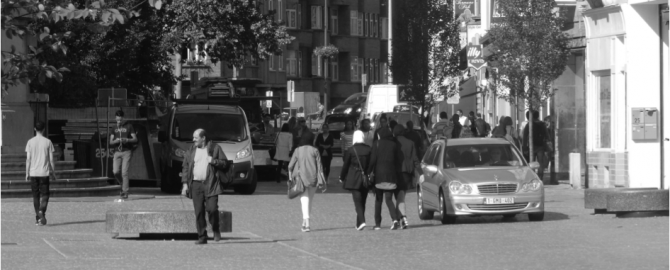by Pierre Vanderstraeten*
May I invite you to share some reflections about the complexity of cohabitation in public spaces, which affects urban safety?
I think that, generally and curiously, we don’t reflect enough on the fact that the nature of this social cohabitation changes with the size of population. More precisely, it changes with the size of potential social interactions – either strong or weak. Indeed, we know that beyond a certain threshold a change in size becomes a change in nature.
For a given size, we can define a first level, which we will call community. This is based on the predominance of personal acquaintances and is pertinent to the concept of territoriality: “The degree of safety of a place – public or private – depends considerably on the sense of belonging of the users and their identification with the place, because people respect and protect the places they feel as theirs.” [1]
Then there is a second level that we can define as the society level. This is based on the predominance of anonymity, and we could argue that attentiveness, a kind of ‘veillance’ rather than surveillance, takes the place of territoriality. In the urban context, this attentiveness can be characterized by the “civil inattention” as Erving Goffman described it: “What seems to be involved is that one gives to another enough visual notice to demonstrate that one appreciates that the other is present (and that one admits openly to having seen him) while at the next moment withdrawing one’s attention from him so as to express that he does not constitute a target of special curiosity or design.”[2] These unconscious social routines ensure a peaceful co-presence in public spaces, described as “social half-heartedness” by some sociologists.
There is nothing really new at these first two levels. We know that cities are made of differentiated contexts and that safety strategies in environmental prevention must be developed to respond to this differentiation.
But, who can fail to observe today that this multilevel system of social interactions becomes more complex with a third level, now rapidly invading our way of being in the public spaces? This third level emerged with the development of ICT (Information and Communication Technology).
I think it’s interesting to approach this third level through its outcomes in public behaviour.It is possible to talk about a kind of ubiquitous presence which one could summarize as following: “I am so absorbed by my communication over distance via smartphone or headphones that I barely pay any attention to others; I am satisfied with the possibility to react if necessary.” This phenomenon is so new that I don’t really know what to think about its impact on urban safety. I know for sure that we face new safety problems as some dramatic accidents happened over the last few years involving smartphoners and headphoners. I know also for sure that, for example, there is a kind of new ambiguous a-spatial ‘coveillance’[3] between facebook users.
Far from territoriality, this new type of co-presence seems to weaken significantly the susceptibility to attentiveness, which is the underlying principle of strategies aiming to increase the number of pedestrians in public spaces.Thus, particularly, I am asking whether shared public spaces could be able to reduce negative consequences of these new ubiquitous co-presences ? In fact, segregated public spaces (pavements, carriageway…) which dedicate their own lanes to the different users and which weaken social interactions and intelligence to cope with the situation are exacerbated by ICT uses. The issue will be whether the increase of user’s responsibility and the attractiveness of shared public spaces which removes all spatial divisions will be sufficient to counteract this ubiquitous trend by getting it into an appropriate degree ?
[1]AGIS – Action SAFEPOLIS 2006-2007, Planning, urban design and management for crime prevention, handbook, European Commission, Directorate-General Justice, Freedom and Security, p. 36.
[2]Erving GOFFMAN, 1959, The presentation of self in everyday life, ed. Anchor Books, USA.
[3]Surveillance implies a hierarchical relation between individuals. Coveillance doesn’t imply any kind of hierachy; individuals monitor and record themselves by using devices.
__________________
* 
Pierre Vanderstraeten is architect, sociologist and town planner.
See Pierre’s Profile here

